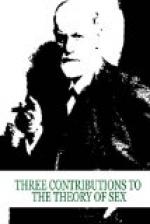REFERENCE TO THE INFANTILISM OF SEXUALITY
By demonstrating the perverted feelings as symptomatic formations in psychoneurotics, we have enormously increased the number of persons who can be added to the perverts. This is not only because neurotics represent a very large proportion of humanity, but we must consider also that the neuroses in all their gradations run in an uninterrupted series to the normal state. Moebius was quite justified in saying that we are all somewhat hysterical. Hence, the very wide dissemination of perversions urged us to assume that the predisposition to perversions is no rare peculiarity but must form a part of the normally accepted constitution.
We have heard that it is a question whether perversions should be referred to congenital determinations or whether they originate from accidental experiences, just as Binet showed in fetichisms. Now we are forced to the conclusion that there is indeed something congenital at the basis of perversions, but it is something which is congenital in all persons, which as a predisposition may fluctuate in intensity and is brought into prominence by influences of life. We deal here with congenital roots in the constitution of the sexual impulse which in one series of cases develop into real carriers of sexual activity (perverts); while in other cases they undergo an insufficient suppression (repression), so that as morbid symptoms they are enabled to attract to themselves in a round-about way a considerable part of the sexual energy; while again in favorable cases between the two extremes they originate the normal sexual life through effective restrictions and other elaborations.
But we must also remember that the assumed constitution which shows the roots of all perversions will be demonstrable only in the child, though all impulses can be manifested in it only in moderate intensity. If we are led to suppose that neurotics conserve the infantile state of their sexuality or return to it, our interest must then turn to the sexual life of the child, and we will then follow the play of influences which control the processes of development of the infantile sexuality up to its termination in a perversion, a neurosis or a normal sexual life.
[1] The facts contained in the first “Contribution” have been gathered from the familiar publications of Krafft-Ebing, Moll, Moebius, Havelock Ellis, Schrenk-Notzing, Loewenfeld, Eulenberg, J. Bloch, and M. Hirschfeld, and from the later works published in the “Jahrbuch fuer sexuelle Zwischenstufen.” As these publications also mention the other literature bearing on this subject I may forbear giving detailed references.
The conclusions reached through the investigation of sexual inverts are all based on the reports of J. Sadger and on my own experience.
[2] For general use the word “libido” is best translated by “craving.” (Prof. James J. Putnam, Journal of Abnormal Psychology, Vol. IV, 6.)




